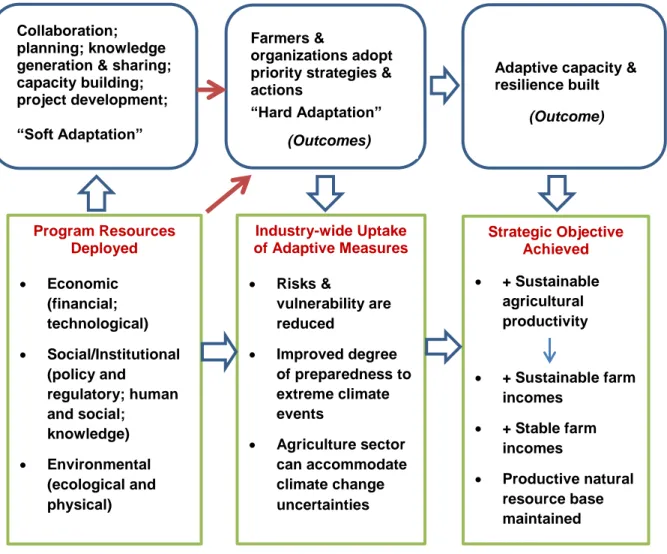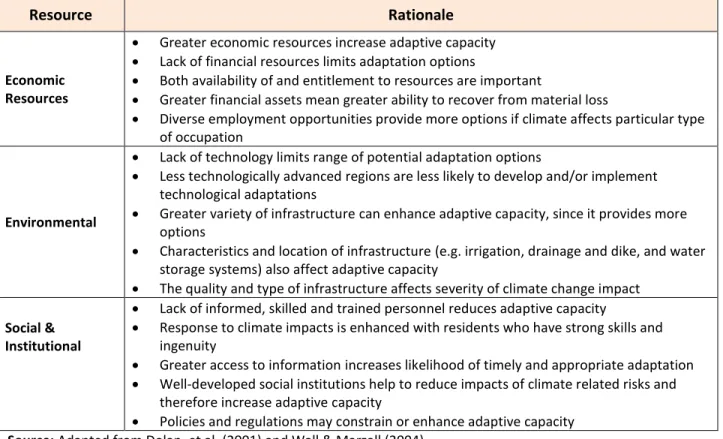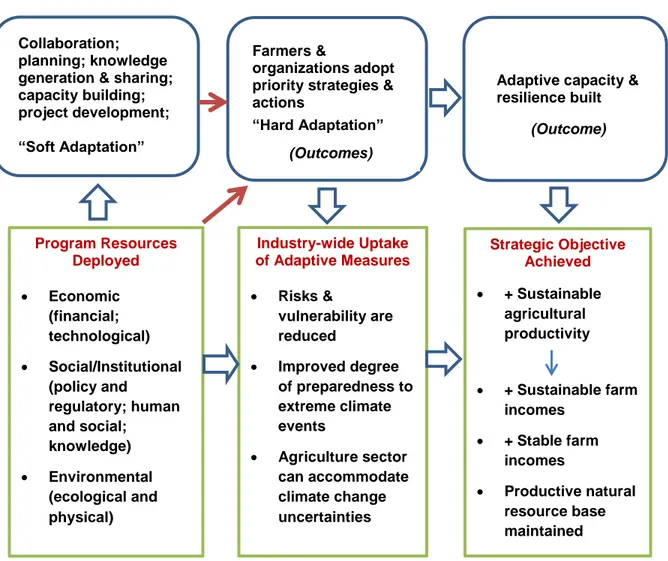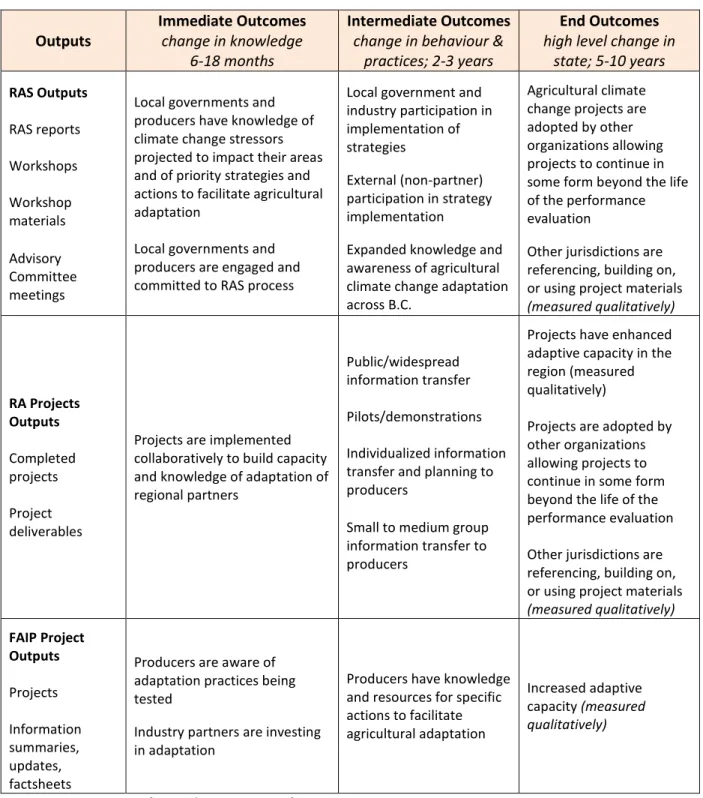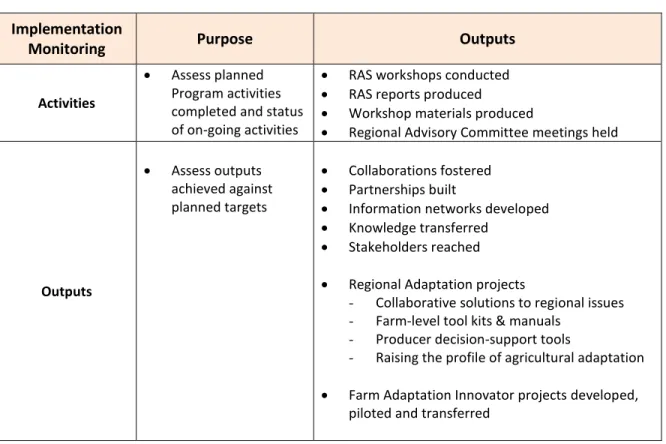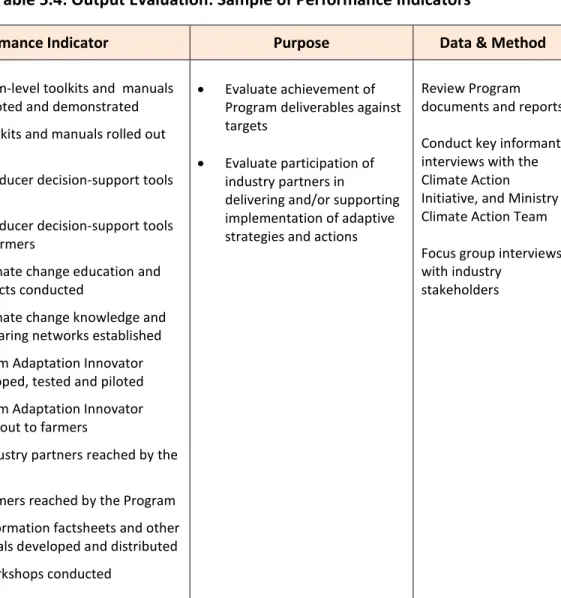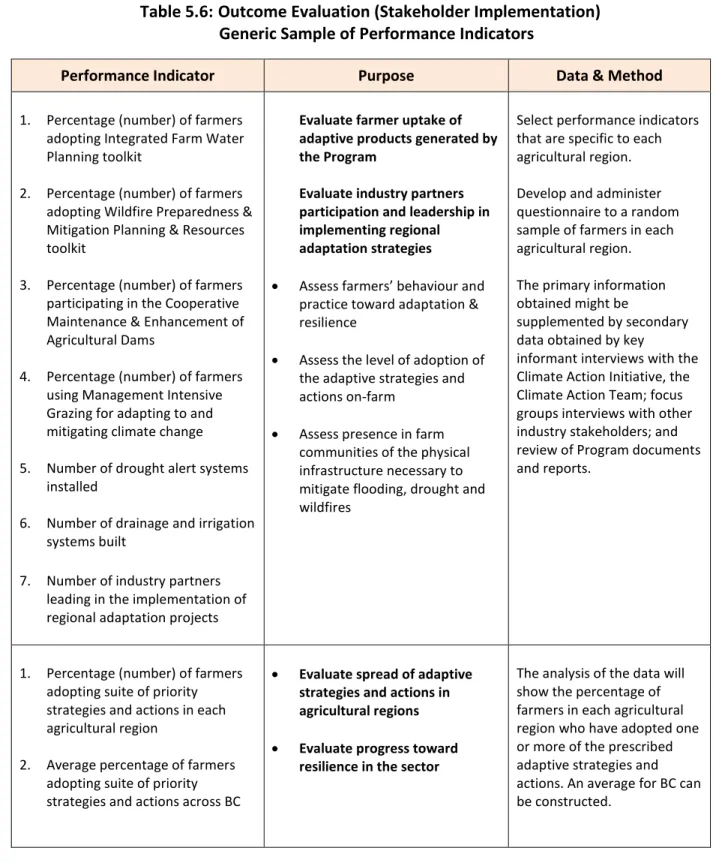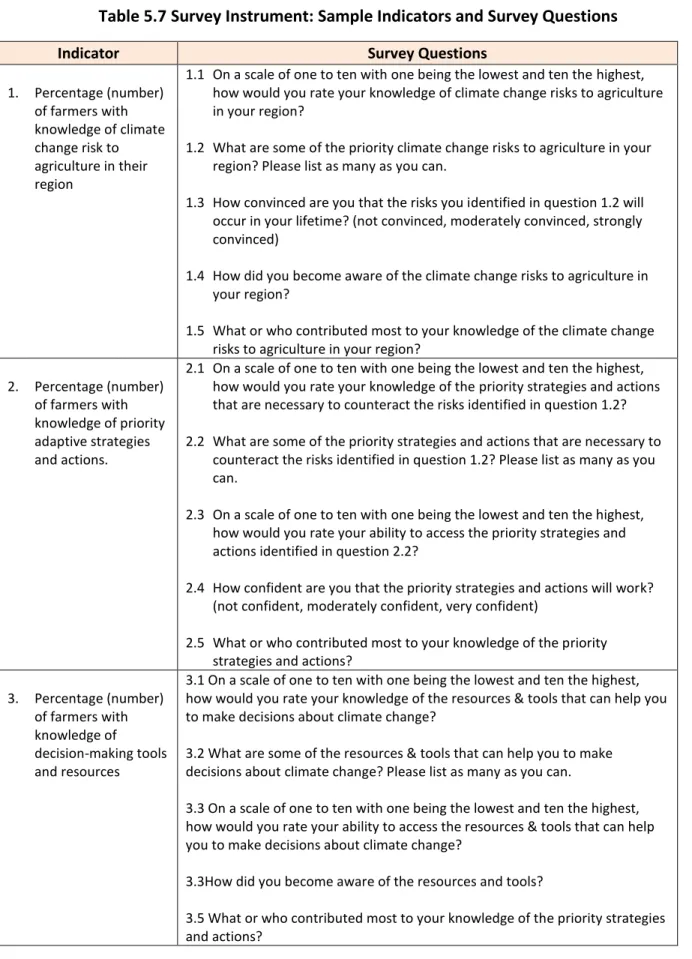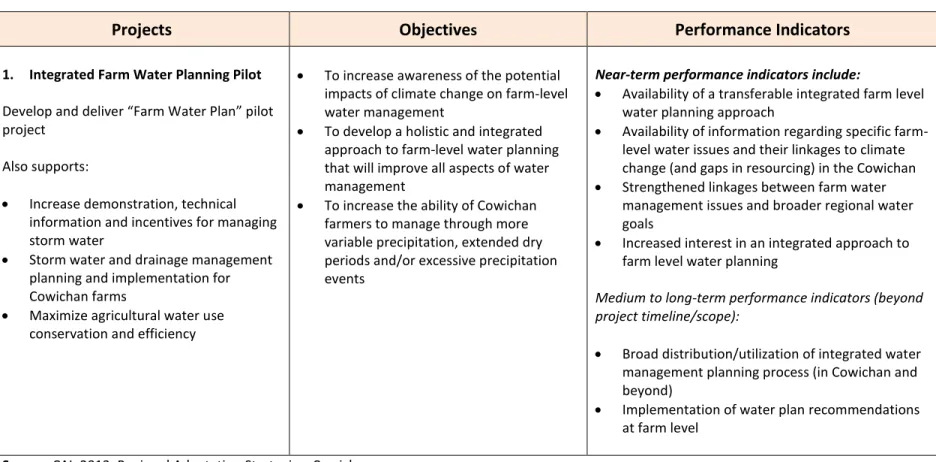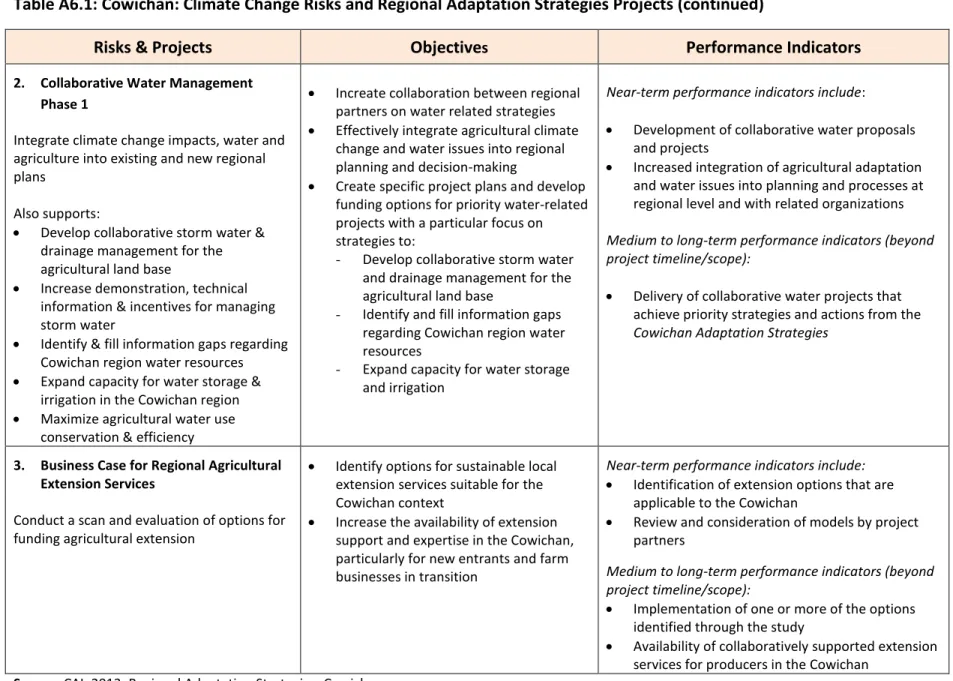Technical Paper
Proposed Performance
Management Framework
Ministry of Agriculture
Climate Change Adaptation Program
December 2015
Prepared By:Anthony Thomas, PhD
Climate Change InternClimate Action Team
Innovation & Adaptation Services Branch B.C. Ministry of Agriculture
1
Report Author
Anthony Thomas has a BSc in Agriculture from the University of Guelph, an MSc in Agriculture and Rural Development from the University of the West Indies, and a PhD in Rural Studies from the University of Guelph. His PhD thesis examined the economic impacts of banana trade changes on the Windward Islands, and included development of sustainable rural development indictors. Dr Thomas has extensive experience as an agricultural professional in contexts that include program delivery, project management, policy development, and livestock development.
Acknowledgements
Internship Funding
This project was completed through an internship funded by the Inter-American Institute for Cooperation on Agriculture (IICA) Canada. IICA supports the efforts of countries in the Americas to achieve agricultural development and rural well-being through international technical
cooperation. The author gratefully acknowledges and thanks IICA Canada for the financial and technical support provided. Special thanks to Trudy Werry for the support given throughout the internship, as well as providing direction and scope. Special thanks also to Kelly Witkowski, for providing direction and scope.
Internship Host
The Innovation and Adaptation Services (IAS) Branch of the British Columbia Ministry of
Agriculture hosted the internship. The support provided by staff of the Ministry of Agriculture is gratefully acknowledged. The B.C. Agriculture and Food Climate Action Initiative also provided direction and scope, and is gratefully acknowledged. The various levels of support and the congenial work environment provided by the IAS Branch are also gratefully acknowledged. The following persons provided valuable support and supervision throughout the internship: Ian McLachlan, Anna Stemberger, Carly Haycroft, and Jenny Romero. The author is grateful for the opportunity to have worked with and to have learned from them.
Disclaimer
The author is solely responsible for the content of this document. The Inter-American Institute for Cooperation on Agriculture (IICA) Canada and the B.C. Ministry of Agriculture are not responsible in any way for losses of any kind that may arise from the use of the information presented in this paper.
Cover photographs (clockwise from top left):
Precipitation in the Fraser Valley, grasshopper damage in the Peace Region, Fraser River flood risk, rangeland in the Cariboo Region. Source: B.C. Ministry of Agriculture.
2
Executive Summary
Climate Adaptation Program
The BC agriculture sector is an important contributor to the economy, with $2.9 billion in farm cash receipts in 2014. The sector is highly diverse, due to BC’s varied topography and climate conditions. The agricultural land base is small, comprising about five percent of the province. Climate change projections indicate that over the coming decades the B.C. agricultural sector will have to deal with significantly changing conditions. B.C. producers will face increased management complexity, business costs, and uncertainty due to impacts such as drought, excess moisture, flood risk, and pests and diseases. There will also be an increase in growing days and opportunities for new crops. Successful adaptation will be required for the industry to manage the risks, take advantage of the opportunities, and maintain growth and profitability. The B.C. Ministry of Agriculture is working in partnership with the industry to build the sector’s adaptive capacity and resilience. Through Growing Forward 2, a federal-provincial-territorial initiative, approximately $5.7 million in funding has been allocated over 2013-2018 to the climate adaptation program.
The program is industry-led and is delivered by the B.C. Agriculture and Food Climate Action Initiative (CAI). (See www.bcagclimateaction.ca for more information).
The program supports the development and implementation of multi-partner regional adaptation strategies in key agricultural areas of the province, and the piloting and demonstration of adaptation practices on B.C. farms and ranches.
The program’s projects provide collaborative solutions to regional issues, farm-level toolkits and manuals, producer decision support tools, and opportunities for knowledge transfer and raising the profile of agriculture adaptation across the sector.
Figure ES.1 and Table ES.2, below, show how the program’s outputs build the first stage of adaptation (“soft adaptation”) and create the circumstances for the second stage (hard adaptation) in which priority strategies and actions are implemented and adaptive practices adopted by producers, local governments, and others.
Performance Management Framework
With the significant investment in adaptation programming, it is important for the Ministry of Agriculture, the B.C. Agriculture Council, producers, and other partners/stakeholders to be able to assess whether the program’s goals are being achieved over the longer term.
The performance management framework (PMF) proposed here builds on the program’s existing performance measurement strategy for 2013-2018 (appended to this report). The PMF goes further, by defining criteria for longer-term success (beyond 2018), metrics for measuring that success, and developing a monitoring and evaluation (M&E) system for program evaluation. The M&E system involves identifying key performance indicators, gathering baseline
3
performance indicators that could be used for the baseline survey, program outputs and program outcomes.
Special design attention must be paid to the long-time frames and unique complexity,
uncertainty, and variability inherent in climate change adaptation and resilience, and to the fact that they are the result of complex changes that cannot be measured directly.
Appropriate resourcing and capacity will be required to implement the PMF and manage the M&E system – to develop M&E plans and schedules; prepare, test and administer surveys; collect and analyze data, prepare and present report, and periodically update the M&E system. A common practice is to allocate 5 to 10 percent of total program cost. For a program similar to the current one, this would correspond to a budget of approximately $250,000 to $500,000 and one full-time staff position over five years.
Recommendations
1: Evaluate financial capacity of sector to invest in adaptation
Financial viability of farms and the economic resources available to them is one of the most important drivers of farm-level adaptation, and therefore of sector resilience. 2: Cost and benefit analysis of agricultural climate change adaption
An economic analysis of the costs and benefits would help demonstrate the societal benefits of investing in of agricultural climate change adaptation in BC.
3: Define criteria for measuring program success
The Program goal is to increase resilience in the sector. Indications of success would include the presence of the proven adaptive technologies and the climate-resilient infrastructure in the sector.
A key question is: What is the optimal level of the presence of the technologies and innovations that credibly represent significant progress towards the Program goal? 4: Establish capacities for M&E
Investments in M&E should be regarded as an essential investment in Program success. In that regard, it is recommended that the resources be mobilized and the capacities for M&E be put in place as soon as it is feasible to do so.
5: Program planning review committee
It is recommended that the Ministry of Agriculture and partners establish a committee to review the program planning and implementation process and make recommendations for ensuring the continuity and sustainability of the Program’s benefits and impact, and for the improvement of future adaptation programs.
Attachments to Executive Summary
Figure ES.1 Pathway To Adaptive Capacity and Resilience Table ES.1 Climate Adaptation Program Logic Model
4
Figure ES.1 Pathway To Adaptive Capacity and Resilience
Program outputs such as collaboration, knowledge and information, resources and tools build the first stage of adaptation (“soft adaptation”) and create the circumstances for the second stage (hard adaptation) in which priority strategies and actions are
implemented and adaptive practices adopted by producers, local governments, and others.
Large-scale adoption would reduce risks and vulnerability and improve preparedness for extreme events, enabling the sector to better accommodate climate change
uncertainties.
These outcomes are expected to lead to sustained and enhanced agricultural productivity and to the overall viability of the agriculture sector (i.e. the program`s strategic objective).
Collaboration; planning; knowledge generation & sharing; capacity building; project development; “Soft Adaptation” 0 Farmers & organizations adopt priority strategies & actions
“Hard Adaptation” (Outcomes)
Adaptive capacity & resilience built (Outcome) Strategic Objective Achieved + Sustainable agricultural productivity + Sustainable farm incomes + Stable farm incomes Productive natural resource base maintained Program Resources Deployed Economic (financial; technological) Social/Institutional (policy and regulatory; human and social; knowledge) Environmental (ecological and physical) Industry-wide Uptake of Adaptive Measures Risks & vulnerability are reduced Improved degree of preparedness to extreme climate events Agriculture sector can accommodate climate change uncertainties
5
Table ES.1 Climate Adaptation Program Logic Model
The logic model shows the relationships among the resources that are invested, the activities that take place, and the impacts and changes that result.
Outputs
Immediate Outcomes
change in knowledge 6-18 months
Intermediate Outcomes
change in behaviour & practices; 2-3 years
End Outcomes
high level change in state 5-10 years Regional Adaptation Strategy Outputs RAS reports Workshops Workshop materials Advisory Committee meetings
Local governments and producers have knowledge of climate change stressors projected to impact their areas and of priority strategies and actions to facilitate agricultural adaptation
Local governments and producers are engaged and committed to RAS process
Local government and industry participation in implementation of strategies External (non-partner) participation in strategy implementation
Expanded knowledge and awareness of agricultural climate change adaptation across B.C.
Agricultural climate change projects are adopted by other organizations allowing projects to continue in some form beyond the life of the performance evaluation
Other jurisdictions are referencing, building on, or using project materials
(measured qualitatively) Regional Adaptation Project Outputs Completed projects Project deliverables
Projects are implemented collaboratively to build capacity and knowledge of adaptation of regional partners
Public/widespread information transfer Pilots/demonstrations Individualized information transfer and planning to producers
Small to medium group information transfer to producers
Projects have enhanced adaptive capacity in the region (measured
qualitatively)
Projects are adopted by other organizations, allowing projects to continue in some form beyond the life of the performance evaluation Other jurisdictions are referencing, building on, or using project materials
(measured qualitatively) Farm Adaptation Innovator Program Project Outputs Projects Information summaries, updates, fact sheets
Producers are aware of adaptation practices being tested
Industry partners are investing in adaptation
Producers have knowledge and resources for specific actions to facilitate agricultural adaptation
Increased adaptive capacity (measured
qualitatively)
6
Table ES.2 Example Performance Indicators for Baseline Survey, Outputs and Outcomes
Baseline Survey Outputs Evaluation Outcomes Evaluation
1. Percentage (number) of farmers with knowledge of climate change risk to agriculture in their region 2. Percentage (number) of
farmers with knowledge of priority adaptive strategies and actions
3. Percentage (number) of farmers with knowledge of decision-making tools and resources
4. Percentage (number) of farmers with budgetary allocations to implement priority strategies and actions 5. Percentage (number) of
farmers seeking to access Program products to plan adaptation efforts 6. Percentage (number) of
farmers seeking technical assistance to implement priority strategies and actions 7. Percentage (number) of
farmers convinced of the risks of climate change to
agriculture
8. Percentage (number) of farmers regarding adaptation to climate change as his/her personal responsibility 9. Percentage (numbers) of
farmers and industry partners implementing any kind of adaptation technology 10. Percentage (number) of
farmers and industry
stakeholders with built climate change resilient infrastructure (e.g. water storage, irrigation, drainage systems)
1. Number of farm-level toolkits and manuals developed, piloted and demonstrated
2. Farm-level toolkits and manuals rolled out to farmers 3. Number of producer decision-support tools developed 4. Number of producer decision-support tools rolled out to farmers 5. Number of climate
change education and outreach projects conducted 6. Number of climate
change knowledge and information sharing networks established 7. Number of Farm
Adaptation Innovator projects developed, tested and piloted 8. Number of Farm
Adaptation Innovator projects rolled out to farmers
9. Number of industry partners reached by the Program
10. Number of farmers reached by the Program 11. Number of information
factsheets and other printed materials developed and distributed
12. Number of workshops conducted
1. Percentage (number) of farmers accessing Agriculture Weather Monitoring & Decision Support Tool 2. Percentage (number) of farmers
accessing Collaborative Pest Monitoring Tool
3. Percentage (number) of farmers using Farm Water Planning toolkit in adaptation planning
4. Number of industry stakeholders and local gov’ts with wildfire
preparedness plans
5. Percentage (number) of farmers with wildfire preparedness plans
6. Number of industry stakeholders and local governments with proposals to upgrade agricultural dams
7. Percentage (number) of farmers participating in the maintenance of agricultural dams
8. Percentage (number) of farmers adopting Integrated Farm Water Planning toolkit
9. Percentage (number) of farmers adopting Wildfire Preparedness & Mitigation Planning & Resources 10. Percentage (number) of farmers
participating in the Cooperative Maintenance & Enhancement of Agricultural Dams
11. Percentage (number) of farmers using Management Intensive Grazing for adapting to climate change 12. Number of drought alert systems
installed
13. Number of drainage and irrigation systems built
14. Number of industry partners leading implementation of regional
adaptation projects
15. Percentage (number) of farmers adopting priority strategies and actions in each agricultural region
7
Table of Contents
Acknowledgements ... 1 Executive Summary ... 2 Acronyms ... 9 Glossary ... 10 1.0 Introduction ... 131.1 Agriculture Climate Change Adaptation Program ... 13
1.2 Purpose of the Paper ... 15
1.3 Structure of the Paper ... 15
2.0 Key Concepts ... 16 2.1 Introduction ... 16 2.2 Resilience ... 16 2.3 Adaptive Capacity ... 17 2.4 Adaptation ... 19 2.5 Conclusion ... 20
2.6 BC Agriculture: Resilience, Adaptive Capacity and Adaptation ... 20
3.0 Best Practices and Considerations In M&E... 22
3.1 Considerations for Climate Change Adaptation M&E ... 22
3.2 Best Practices and Guidance Instruments ... 23
3.2.1 Design M&E system at program planning ... 23
3.2.2 Analysis of program environment ... 24
3.2.3 Fully articulate program philosophy ... 24
3.2.4 Combination of output and outcome indicators ... 24
3.2.5 Recognize the limitations of indicators ... 25
3.2.6 Evaluate planning process ... 26
4.0 Overview of the Performance Management Framework ... 26
5.0 Monitoring & Evaluation (M&E) ... 27
5.1 Approach to M&E ... 27
5.2 Program Logic Model ... 28
5.3 External Factors Affecting Program Outcomes ... 28
5.4 Planned Program Outputs and Deliverables ... 30
5.4.1 Regional Adaptation (RA) projects ... 30
5.4.2 Farm Adaptation Innovator Program (FAIP) projects... 31
8
5.5.1 Beneficial Management Practices (BMP) Program ... 31
5.5.2 Agriculture Water Demand Model (AWDM) ... 32
5.6 Overview of M&E System ... 32
5.6.1 Monitoring ... 33
5.6.2 Evaluation ... 34
5.7 Considerations for M&E ... 34
5.7.1 Define criteria for Program success ... 34
5.7.2 Resources for implementing M&E system ... 35
5.7.3 Data and information requirements ... 35
5.7.4 Sample frame, sampling and sample size ... 36
5.7.5 Reports and reporting ... 36
5.7.6 Summary measure of adaptive capacity and resilience (optional) ... 36
5.7.7 Update M&E system ... 37
5.8 Operationalizing the M&E System ... 37
5.8.1 Baseline survey ... 37
5.8.2 Evaluation of Program outputs ... 39
5.8.3 Evaluation of Program outcomes ... 40
5.8.4 Evaluate Program planning process ... 43
6.0 Conclusions and Recommendations ... 46
6.1 Conclusions ... 46
6.2 Recommendations ... 47
7.0 References ... 49
Appendix 1: Selected Social/Institutional Output and Outcome Resilience Indicators ... 54
Appendix 2: Selected Economic Output and Outcome Resilience Indicators ... 55
Appendix 3: Selected Environmental Outcome Climate Change Resilience Indicators ... 55
Appendix 4: Climate Change Risks & Regional Adaptation Projects ... 56
Appendix 5: Farm Adaptation Innovator Program (FAIP) Projects ... 57
Appendix 6: Regional Adaptation Strategies Projects ... 58
Table A6.1: Cowichan Regional Adaptation Strategies Projects ... 58
Table A6.2: Delta: Climate Change Risks and Regional Adaptation Strategies Projects ... 61
Table A6.3: Cariboo: Climate Change Risks and Regional Adaptation Strategies Projects ... 65
Table A6.4: Peace: Climate Change Risks and Regional Adaptation Strategies Projects ... 67
Table A6.5: Fraser Valley: Climate Change Risks and Regional Adaptation Strategies Projects ... 70
Appendix 7: B.C. Ministry of Agriculture Climate Change Adaptation Program Performance Measurement Strategy 2013-2018 ... 71
9
Acronyms
BC British Columbia
CAI BC Agriculture & Food Climate Change Action Initiative CAT Climate Action Team
CCAP Climate Change Adaptation Program
FAO Food and Agriculture Organization of the United Nations
PMF Performance Management Framework
PMS Performance Management Strategy
M&E Monitoring and Evaluation
OECD Organization for Economic Cooperation and Development RAS Regional Adaptation Strategies
RAP Regional Adaptation Projects
10
Glossary
Adaptation: Adjustment in natural or human systems in response to actual or expected climatic
stimuli or their effects, which moderates harm or exploits beneficial opportunities.
Adaptive capacity: The ability of a system or a sector to adjust to climate change (including
climate variability and extremes) to moderate potential damages, to take advantage of opportunities, or to cope with the consequences.
Adaptive management: A process of iterative learning about a system or program to generate
knowledge that can be used to gain the best short-term outcomes, as well as improve management outcomes in the future.
Anticipatory adaptation: Adaptation that takes place before impacts of climate change are
observed.
Autonomous adaptations: Adjustments individuals make in response to climate change in the
absence of government incentives or action. For example, an agricultural producer may choose to upgrade his or her irrigation infrastructure to improve the farm’s productivity, or pilot a new variety of crop which they judge to be better suited to the changing regional climate.
Baseline information: Information usually consisting of facts and figures collected at the initial
stages of a program or project and that provides a basis for measuring progress in achieving program or project outputs, outcomes and impacts.
Baseline survey: An analysis describing the situation in a program or project area. It includes
data on individual stakeholders prior to a development intervention. Progress (results and accomplishments) can be assessed and comparisons made against the baseline survey. It also serves as an important reference for the completion evaluation.
Capacity: The ability of individuals and organizations to perform functions effectively, efficiently
and in a sustainable manner.
Climate variability: Variations in the mean state and other statistics (such as standard
deviations, or statistics of extremes) of the climate on all temporal and spatial scales beyond that of individual weather events.
Climate change: A change of climate that is attributed directly or indirectly to human activity
that alters the composition of the global atmosphere and that is in addition to natural climate variability observed over comparable time periods.
Evaluation: Evaluation is an assessment of a planned, ongoing, or completed intervention to
11
Goal: The higher-order program or sector objective to which a development intervention, such
as a project, is intended to contribute. Thus it is a statement of intent.
Hard adaptation: Refers to adaptation measures that can be more readily quantified, e.g. water
storage facilities built, irrigation systems installed, drainage and dike systems constructed.
Indicator: Quantitative or qualitative factor or variable that provides a simple and reliable basis
for assessing achievement, change or performance. A unit of information measures over time that can help show changes in a specific condition. A given goal or objective can have multiple indicators.
Impact: To have a strong, negative and direct impact on a person or system.
Logical framework: An analytical, presentational and management tool that involves problem
analysis, stakeholder analysis, developing a hierarchy of objectives and selecting a preferred implementation strategy.
Monitoring and evaluation (M&E): The combination of monitoring and evaluation which
together provide the knowledge required for: a) effective project management and b) reporting and accountability responsibilities.
Monitoring: Monitoring is a continuous process of collecting and analyzing information to
compare how well a project, or program or policy is being implemented against expected results.
Monitoring & evaluation system: An M&E system is a management information system (MIS)
that provides data to management regarding the operation and effects of the project.
Output: The amount of something produced or generated by a person, system or program in a
given period of time.
Outcome: A final product or the desired end result arising from some action or intervention. Planned adaptations: Adaptive actions taken by government to provide public goods or
incentives to motivate action by the private sector. Governments may choose to participate in planned adaptation because certain adaptation actions have benefits that cannot be captured by private individuals, resulting in under-investment. Some examples would include
development of new irrigation infrastructure, land-use arrangements and property rights, water pricing and training for the private and public sector (capacity building).
Qualitative: Something that is not summarized in numerical form, such as minutes from
community meetings and general notes from observations. Qualitative data normally describe people’s knowledge, attitudes or behaviours.
12
Quantitative: Something measured or measurable by, or concerned with, quantity and
expressed in numbers or quantities.
Resilience: The capacity of a system to cope with change, and to withstand stresses and
catastrophe.
Risk: The likelihood of an event occurring combined with the severity of expected impacts. Stakeholders: An agency, organization, group or individual with a direct or indirect interest in
the program, or who is affected positively or negatively by the implementation and outcome of the program.
Soft adaptation: Refers to adaptation measures that are more qualitative in nature, such as
institutions and communication networks established, collaborative action fostered, and planning and development processes.
Mainstreaming: The process of integrating climate risks and adaptation issues into traditional
sectoral development and investment practices.
Vulnerability: The degree to which a system is susceptible to and unable to cope with the
adverse effects of climate change, including climate variability and extremes. Vulnerability is a function of the character, magnitude, and rate of climate change and variation to which a system is exposed, its sensitivity, and its adaptive capacity.
13
1.0 Introduction
1.1 Agriculture Climate Change Adaptation Program
Background
The BC agriculture sector is an important contributor to the economy, with $2.9 billion in farm cash receipts in 2014 (Ministry of Agriculture, 2015). Due to the province’s varied topography and climate conditions, the sector is highly diverse, with grain, oilseeds, and forage seeds produced in the Peace Region, cattle and ranches in the southern and central interior, tree fruits and grapes in the Okanagan Valley, and a range of farm types in the Lower Mainland and Vancouver Island (berries, vegetables, dairy, and poultry) (Climate Action Initiative, 2012). The agricultural land base is proportionately very small, comprising about five percent of BC. The scope and the scale of projected climate change impacts on BC agriculture are expected to be unprecedented. This will result in increased management complexity, business costs, and uncertainty, due to impacts such as drought, excess moisture, flood risk, and pests and diseases. There will also be an increase in growing days and opportunities for new crops. Successful adaptation will be required for the industry to manage the risks and take advantage of the opportunities.
The B.C. Ministry of Agriculture is working in partnership with the industry to build the sector’s adaptive capacity and resilience. Through Growing Forward 2, a federal-provincial-territorial initiative, approximately $5.7 million in funding has been allocated over 2013-2018 to the climate adaptation program.
The program is industry-led and is delivered by the B.C. Agriculture and Food Climate Action Initiative (CAI). (See www.bcagclimateaction.ca for more information).
The program supports the development and implementation of multi-partner regional adaptation strategies in key agricultural areas of the province, and the piloting and demonstration of adaptation practices on B.C. farms and ranches.
The overarching assumption is that adaptation and adaptive capacity will enhance the sector’s resilience to climate change. Resilience will enable the sector to maintain long-term
productivity and viability amid climate variability. (CAI, 2013 Risk & Opportunity Assessment). Approach to resilience
The Program approaches resilience through building adaptive capacity in the sector. This is achieved by deploying policy and regulatory resources, financial resources, human and social resources, knowledge resources, and physical resources in the sector. The resources build the capacity and create the enabling and supportive environment in which adaptation and
resilience are realized. Section 2 of the paper explains in more detail the concepts of adaptive capacity, adaptation and resilience.
14 Priority strategies and actions
At the regional scale, priority strategies and actions are developed through participatory and stakeholder-led processes involving agricultural producers, farmers’ organizations, provincial government ministries, local governments, and other partners. The priority strategies and actions are detailed in the Regional Adaptation Strategies (RAS).1 Potential partners, including possible lead organizations are identified for projects addressing each priority action. The potential partners are expected to play a leading and/or supportive role in providing oversight during implementation of the regional strategies and actions (CAI, 2013 Regional Adaptation Strategies series).
The RAS projects address the complex regional adaptation issues that are beyond the capacity of individual farmers, and include research, analyses and pilots/demonstrations that are to generate information, recommendations, adaptation options, resources and tools to facilitate adaptation decision-making, planning and action.
A full listing of the RAS projects is provided in Appendix 6. The projects are broadly categorized as:
collaborative solutions to regional issues, e.g. the project in the Cariboo region dealing
with cooperative maintenance and enhancement of agricultural dams, and the Cowichan region project to pilot a drought alert system;
farm-level tool kits and manuals, e.g. Cowichan integrated farm water planning pilot;
producer decision support tools, e.g. agriculture weather monitoring and collaborative
pest monitoring projects in the Peace region;
knowledge transfer, e.g. the water storage knowledge transfer resources project in the
Cowichan region; and
raising the profile of agricultural adaptation, e.g. agriculture and climate change
education and outreach in Delta.
Adaptation at the farm level is supported through the Farm Adaption Innovator Program (FAIP), which focuses on adaptive capacity in physical resources, knowledge resources, and human and social resources. The FAIP generates innovations in farm practices, approaches and
technologies that modify farm production practices and build the climate-resilient infrastructures that can accommodate climate change shocks and climate variability. It is intended that if the program outputs are shown to be useful, they will be rolled out more broadly and that farmers will integrate them into farming operations. Appendix 5 lists the FAIP projects.
The implicit assumption in Program documents seems to be that agricultural producers and industry stakeholders in each agricultural region would access and apply the decision-making
1 Regional Adaptation Strategies have been completed for Cowichan, Delta, the Peace, the Cariboo, the Fraser
Valley. A regional strategy for the Okanagan was underway at time of writing. The RAS documents are available at:
15
tools in adaptation matters, and implement the suite of proven adaptive technologies and innovations in sufficiently large numbers to enable the sector to mitigate and adjust to the projected climate change stressors and risks. The level of adoption is expected to be self-sustaining in the long-term, which is well beyond the duration of the current Program.
1.2 Purpose of the Paper
In 2014 the Ministry of Agriculture developed a Performance Measurement Strategy (PMS) for the Program for 2013-2018. The PMS clearly defines the Program goal and reports planned outputs, the expected responses of stakeholders, and timeframes for achieving immediate, intermediate and end outcomes. However, because the PMS concerns only the first five years of the program, it does not define the criteria for longer-term success of the Program success and the metrics for measuring that success. Also, a systematic framework and accompanying monitoring and evaluation (M&E) system to formally evaluate the Program are yet to be developed. Therefore, this paper extends the PMS by developing a performance management framework (PMF) and M&E system to systematically evaluate the Program. The PMF highlights the Program approach to resilience, defines a logical pathway to resilience, proposes the criteria for measuring Program success and the metrics for measuring that success, and
develops a set of contextually sensitive performance indicators that are related to the Program goals and deliverables. The expected responses of farmers and industry stakeholders to the products generated by the Program, and their participation in implementing adaptive priority strategies at farm and regional levels are also evaluated.
1.3 Structure of the Paper
The paper is structured as follows:
Section 2 briefly explains the key concepts of resilience, adaptation and adaptive capacity that are widely used in Program documents, and establishes the conceptual and operational linkages among them;
Section 3 highlights best practices and guidance instruments in M&E of agriculture climate change adaptation programs;
Section 4 is an overview of the performance management framework; and
Section 5 outlines the approach to M&E and how the system might be operationalized.
16
2.0 Key Concepts
2.1 Introduction
This section explains the key concepts widely used in the Program documents. These include including resilience, adaptation and adaptive capacity. The conceptual and operational nexus among resilience, adaptive capacity and adaptation, as well as the Program’s approach to building adaptive capacity and resilience are highlighted.
2.2 Resilience
Resilience is defined and operationalized in a number of different ways. The IPCC (2012) in Brook et al. (2013)defines resilience as “the ability of a system and its component parts to anticipate, absorb, accommodate, or recover from the effects of a hazardous event in a timely and efficient manner.” A system may be made more resilient in a number of ways, including by managing human and environmental components in a manner that maintains the system’s status quo (such as managing water resources to better cope with drought) or transforming into a new system when the current system becomes untenable, e.g. eliminating irrigation and agricultural production if drought risk is too extreme (Engle 2011, Walker et al. 2006, and Folke 2006).
In the context of climate change resilience is generally defined as being able to respond to, cope with and recover from climate variations and impacts, i.e., remaining in or returning to the old state or even developing a new state [positive change] in response to climate impacts (Malone 2009 and Ibarrarán et al.2008). Resilience includes coping strategies, awareness, plans and the capacity to respond (adaptive capacity) and prior adaptation actions to reduce the impacts of climate change. In this context resilience overlaps significantly with adaptation, to the point that it is often used as a synonym for adaptation.
Resilience: an operational approach
Four broad approaches to operationalizing resilience are used in the literature: (1) vulnerability approach (2) adaptive capacity approach (3) formal capitals approach and (4) components and determinants of resilience approach. The BC Agriculture Climate Change Program uses the adaptive capacity approach to build resilience to climate change. In that approach resilience is understood as the presence of, and the deployment of, set of resources and capacities (Béné e.t al. 2012 in Lisa et al. 2015).
Swanson et al. (2009) observed that some commentators use the terms “resilience” and “adaptive capacity” interchangeably, while others implicitly equate resilience with adaptive capacity. Elasha et al. (2005) also seem to suggest that assessing adaptive capacity is the equivalent of assessing [community] resilience. Berkes and Jolly (2001) in Ellis (2014) collected data and measured communities’ adaptive capacity even though socio-ecological resilience was
17
their primary focus. Malone (2009) proposed that the similarity between resilience and adaptive capacity might allow the measurements used in adaptive capacity approaches to be used in measuring resilience. The previous examples suggest that resilience is considered to be akin to adaptive capacity. The two terms are often utilized in conjunction with each other. Building adaptive capacity builds resilience, i.e. the outcome of adaptive capacity is resilience to climate change. Appendices 1-3 show a generic set of output and/or outcome resilience
indicators that are commonly associated with agricultural climate change adaptation.
2.3 Adaptive Capacity
Adaptive capacity is generally described as the presence of necessary resources and the capacity of people to mobilize those resources to build resilience over the short, medium and long terms. The key features of adaptive capacity as applied to agriculture include the ability of the industry to: (1) take deliberate and planned adaptation decisions and actions in anticipation of climate change events, when climate change events are about to happen, and when climate change events have occurred (2) avoid or minimize potential damages of climate change (3) cope with the consequences of damages when they occur, and (4) take advantage of the opportunities presented by climate change (FAO, 2013).
Wall & Marzall (2004), in a study conducted in Ontario to assess adaptive capacity in rural communities for meeting climate and weather risks, posited that adaptive capacity depends on social, human, institutional, natural and economic resources. Swanson et al. (2009) list
economic resources, technology, information and skills, infrastructure, institutions, and equity as determinants of adaptive capacity. The CAI (2012) listed five interrelated types of resources or categories of adaptive capacity: (1) Financial Resources (2) Physical Resources (3) Human and Social Resources (4) Knowledge Resources, and (5) Policy and Regulatory Resources. For
convenience, the adaptive resources are partitioned into social and institutional resources, economic resources, and environmental resources as depicted in Table 2.1.
Table 2.2 highlights the relationship between the categories of adaptive resources and resilience to climate change. It posits that greater economic resources increase adaptive capacity, while the lack of financial resources limits adaptation options. Likewise, policies and regulations may constrain or enhance adaptive capacity. Economic policies and resources influence technological developments, capacity building, and social, institutional and physical infrastructures. In that regard, financial viability may be considered as a base requirement for agricultural systems to adapt to climate change, and policies and regulations as that which frames the capacity of agricultural producers and stakeholders to build resilience in the sector. The discussion above is intuitive: building resilience in the agriculture sector requires a
supportive and enabling policy and regulatory framework, adequate financial resources, and built capacity of agricultural producers.
18
Table 2.1: Resources of Adaptive Capacity in Agriculture
Resource Sub-Component Indicator Group
Economic 1. Financial 2. Technological
Markets, processing
Farm income
Insurance & risk management
Access to financial resources
Technological resources
Social & Institutional
1. Policy & Regulatory Resources
2. Human & Social Resources
3. Knowledge Resources
Government programs & services
Regulatory mechanisms & governance structure
Networks associations & resource sharing
Farm operators & labour
Community & interface
Research development & technology
Access to information & extension
Knowledge, experience, perceptions, education & skills
Environment 1. Ecological
2. Physical Resources
On farm infrastructure
Off farm & regional infrastructure
Land, water & ecology
Source: Modified from Miller et al. (2013); CAI (2012); and Wall & Marzall (2004)
Table 2.2: Nexus: Adaptive Resources and Adaptive Capacity
Resource Rationale
Economic Resources
Greater economic resources increase adaptive capacity
Lack of financial resources limits adaptation options
Both availability of and entitlement to resources are important
Greater financial assets mean greater ability to recover from material loss
Diverse employment opportunities provide more options if climate affects particular type of occupation
Environmental
Lack of technology limits range of potential adaptation options
Less technologically advanced regions are less likely to develop and/or implement technological adaptations
Greater variety of infrastructure can enhance adaptive capacity, since it provides more options
Characteristics and location of infrastructure (e.g. irrigation, drainage and dike, and water storage systems) also affect adaptive capacity
The quality and type of infrastructure affects severity of climate change impact Social &
Institutional
Lack of informed, skilled and trained personnel reduces adaptive capacity
Response to climate impacts is enhanced with residents who have strong skills and ingenuity
Greater access to information increases likelihood of timely and appropriate adaptation
Well‐developed social institutions help to reduce impacts of climate related risks and therefore increase adaptive capacity
Policies and regulations may constrain or enhance adaptive capacity Source: Adapted from Dolan, et al. (2001) and Wall & Marzall (2004)
19
2.4 Adaptation
In the literature, resilience is often used as a synonym for adaptation and for vulnerability and risk reduction. According to FAO/OECD (2012), “Resilience can be described as the capacity of systems, communities, households or individuals to prevent, mitigate or cope with risk, and recover from shocks.” Greater resilience can be achieved by reducing vulnerabilities and increasing adaptive capacity. This can be achieved by reducing exposure, reducing sensitivity and increasing adaptive capacity.
Adaptation can be directed to reduce the potential risks, or to benefit from opportunities associated with climate change. Adaptation in the context of agriculture refers to the capacity of agricultural production systems to withstand the stresses imposed by climate change, and to maintain or surpass levels of productivity.
The goal of adaptation is to build the adaptive capacity that enhances resilience of the agriculture sector to climate change.
The suite of adaptation strategies in agriculture ranges from:
Routine farm management measures and practices (e.g. changing timing of operations, adoption of conservation tillage practices and diversification in production systems);
Specific farm measures and practices that mitigate climate change risks (e.g. water management and water storage, drainage and flood protection systems, wildfire risk reduction, and pest and disease monitoring and management);
Technological innovations (e.g. crop development, early warning systems, land and water use options, engineering solutions, diversification of production, intensification of production);
Investment of funds by public agencies in order to develop or improve irrigation schemes;
Modification of farm support programs; and
Development of new plant varieties.
Some of the climate change literature categorizes adaptation as either “soft adaptation” or “hard adaptation”. Soft adaptation refers to those aspects of climate change adaptation and resilience that are not easily quantified, such as planning processes, knowledge and skills development, and the building of institutions and networks. Hard adaptation, on the other hand, refers to those aspects of climate change adaptation and resilience that are more easily quantified, such as the numbers of irrigation systems built, dams constructed, hectares of land terraced, or farms establishing adequate drainage systems. Soft adaptation (regarded as the precursor to hard adaptation) generates the knowledge and information that enables
stakeholders to make decisions about hard adaptation and creates the capabilities among them to implement the adaptive strategies and actions that correspond to hard adaptation. Soft adaptation builds the foundation for hard adaptation.
20
The main distinction between soft adaptation and hard adaptation seem to be that whereas the former is more concerned with the development of knowledge and information, planning, capacity building, preparation and delivery of adaptation resources (the process of adaptive capacity) that enable stakeholders to adapt to climate change, the latter emphasizes the physical and concrete on-farm, community and regional implementation of adaptive measures and practices that directly counteract climate change impacts and thus strengthen resilience (outcome of adaptive capacity). However, it should be noted that in some contexts, soft
adaptation may also refer to institutional changes such as the provision of public flood warning and risk information, and the organization of local emergency groups that use the information. These are regarded as adaptive measures, but may not involve physical infrastructure.
2.5 Conclusion: Adaptive Capacity and Resilience
The literature concerned with agriculture adaptation to climate change suggests that the terms resilience, adaptive capacity and adaptation, are for the most part synonymous with the ability of the agriculture sector to adapt to climate change, i.e. reduce climate related risks, withstand and rebound from climate change impacts, and remain viable. However, while the outcomes are the same, there appear to be subtle differences in the usage. Adaptation and adaptive capacity seem to involve both processes and outcomes, while resilience seems to be more of an outcome with adaptation and adaptive capacity as the process of building resilience.
Governments (or affiliated organizations) are usually the primary agents in building adaptive capacity, while primary agents in adaptation can be governments (planned adaptation) or farmers (autonomous adaptation). In spite of the apparent differences, resilience, adaptive capacity and adaptation are in principle conceptually and operationally similar, with
considerable overlap among them. Therefore, we assume here that programs directed to
building adaptive capacity will build resilience to climate change.
2.6 BC Agriculture: Resilience, Adaptive Capacity and Adaptation
The B.C. Ministry of Agriculture’s Climate Change Adaptation Program took the adaptive capacity approach to building resilience to climate change. The Program avers that adaptation will enhance the sector’s resilience and capacity to remain viable in the face of climate
variability. Adaptive resources to increase the resilience of the industry have been deployed, albeit at an initial level (see Table 2.1) to reduce the climate related risks in agricultural regions of B.C., improve the preparedness for extreme climate events and help the sector to better accommodate climate change uncertainties. These outcomes are in turn expected to enhance agricultural productivity and the competitiveness and viability of agriculture in a changing climate.
Figure 2.1 depicts the pathway to resilience that is implicit in the Program documents. Program outputs include: stakeholder collaboration fostered; climate change knowledge and
21
developed, piloted and tested. These outputs, which better correspond to the concept of soft adaptation, build what might be regarded as the first stage of adaptive capacity, and create the environment for launching the second stage (hard adaptation), i.e. the implementation of the priority strategies and actions.
The intent is that the priority strategies and actions would diffuse through the agriculture sector as agricultural producers, farmer’s organizations and local governments (in sufficiently large numbers) voluntarily implement them. Large-scale adoption of the priority strategies and actions would reduce risks and vulnerability and improve preparedness for extreme events, enabling the sector to better accommodate climate change uncertainties. These outcomes are expected to lead to sustained and enhanced agricultural productivity and to the overall viability of the agriculture sector (i.e. the Program`s strategic objective).
Figure 2.1: Pathway to Adaptive Capacity and Resilience
Collaboration; planning; knowledge generation & sharing; capacity building; project development; “Soft Adaptation” 0 Farmers & organizations adopt priority strategies & actions
“Hard Adaptation” (Outcomes)
Adaptive capacity & resilience built (Outcome) Strategic Objective Achieved + Sustainable agricultural productivity + Sustainable farm incomes + Stable farm incomes Productive natural resource base maintained Program Resources Deployed Economic (financial; technological) Social/Institutional (policy and regulatory; human and social; knowledge) Environmental (ecological and physical) Industry-wide Uptake of Adaptive Measures Risks & vulnerability are reduced Improved degree of preparedness to extreme climate events Agriculture sector can accommodate climate change uncertainties
22
Caveat: Adaptation Programs
Moser (2009), in Tompkins et al. (2010), observes that simply because individuals, organizations or regions have the knowledge, capacity and resources to undertake adaptation, does not guarantee action, i.e. that adaptation is happening. Common barriers to adaptation include the public good nature of threatened resources, a failure in collective decision-making, a lack of clarity over who is responsible for action (public or private sector) and other factors (Tompkins et al. 2005 in Tompkins et al. 2010). The message is that it should not be assumed that
adaptation is happening; that adaptation is happening must be demonstrated by evidence. A performance management framework can help to generate the evidence that allows judgments to be made about whether or not program outcomes are realized, i.e. adaptation or adaptive capacity is being built. A performance management framework can also help to satisfy the need for accountability and provide opportunities for learning.
3.0 Best Practices and Considerations In M&E
While many organizations and institutions have identified M&E of climate change adaptation programs as a core component of climate risk management and adaptive planning (Preston et al. 2011), the research on how to monitor and evaluate climate change adaptation programs appears to be at an early stage, and consequently there is currently no one way to approach M&E of adaptation interventions (Ford et al. 2013 and GIZ 2013).2 However, some best
practices and factors that are to be considered in M&E of climate change adaptation programs are emerging. Some of the practices in the literature are highlighted below.
3.1 Considerations for Climate Change Adaptation M&E
Climate change adaptation programs are not regular development programs
Adapting to climate change involves decision-making “with continuing uncertainty about the severity and timing of climate change impacts” (OECD, 2015). The M&E system must take into account the complexity, uncertainty and variability inherent in climate change adaptation and resilience, and be guided accordingly (Dinshaw et al. 2014). Some of the unique characteristics of climate change adaptation are shown below.
1. Long time frames – climate change is a long-term process that can extend beyond the span of usual program management cycles. The real impact of climate change
adaptation interventions may not be apparent for decades.
2
The USA, Kenya, Morocco, Tunisia, Northern Ireland, Wales, Scotland, Germany, Finland, the Philippines and the United Kingdom are in the process of developing adaptation indicators and M&E frameworks. Some of these countries(Germany, Finland, the Philippines and the United Kingdom) are more advanced in the process than others.
23
2. Measuring non-events – particular adverse weather may not occur during the program cycle, and “success” may constitute stabilization or preparedness rather than improved adaptive capacity or resilience.
3. Lack of universal indicators – while there are unambiguous indicators for climate change itself (e.g. average global temperature, CO2 levels), adaptation and resilience must be contextualized to a sector, locale or region. In the context of BC, indicators that correspond to the local conditions must be developed.
4. Some aspects of climate change and resilience (e.g. institutional capacity, behaviour change) are not always measurable, and, for those, qualitative assessments might be more appropriate or feasible.
5. Contribution versus attribution – M&E approaches usually seek to demonstrate that changes can be attributed specifically to a particular intervention. However, the complexity of agricultural climate change adaptation and related interventions (multi-sectoral responses, cross-thematic focus, and long time frames) may require that program implementers simply demonstrate how their program contributes to overall adaptation.
6. The inability to unambiguously define endpoints for agricultural adaptation and resilience given the complex nature and the state of flux in the social, economic and ecological factors concerned with them.
7. Other: measurements may involve a range of stakeholders; M & E is not incorporated into project design; and obtaining data may be expensive, complex, and difficult. The implication of these caveats is that, given the complex and dynamic and non-linear characteristics of agricultural climate change adaptation and resilience, the traditional approaches to M&E need to be modified. This paper is guided by these considerations.
3.2 Best Practices and Guidance Instruments
3.2.1 Design M&E system at program planning
The M&E framework should be designed when the adaptation plans are being formulated, and operationalized at program commencement. The M&E system can then monitor
implementation progress to ensure that the program is implemented properly, that it achieves the desired outcomes, and that learning is provided to improve the design of future programs (FAO, 2013). It is very difficult to reverse engineer M&E into a program after it is designed and implemented.
24 3.2.2 Analysis of program environment
Climate change adaptation programs do not operate in vacuums, but are affected by factors in the environments in which they are implemented. It is therefore necessary that to the extent possible, a comprehensive analysis of the social, economic, political, legal and educational factors that might affect program implementation should be performed. The analysis will reveal
ex ante the relevant external factors that must be accommodated in developing and
implementing programs.
3.2.3 Fully articulate program philosophy
The programs’ scope, philosophy, mission, vision, objectives, goals and timeframes should be fully articulated and stated in the plan. This makes clear the premises under which the program will be operating and what the expectations are at given times.
3.2.4 Combination of output and outcome indicators
Lamhauge et al. (2011) divided climate adaptation interventions into five categories. This report partitions those categories into two broad classes, to frame and organize output and outcome indicators.
1) Adaptive strategies and practices that directly reduce climate risks and build the
resilience of the agriculture sector.
These activities have the most direct impact on agricultural stakeholder’s ability to adapt to climate, and include adaptive measures such as water conservation, and flood prevention.
They correspond to “hard adaptation” and can be tracked and measured by outcome indicators.
2) Interventions that influence the resilience of the agriculture sector.
These activities correspond to “soft” adaptation and can be tracked and measured by output or process indicators, and include:
a) Policy and administrative management for climate change, i.e. activities that ensure climate change risks are mainstreamed into policies and regulations, planning, and negotiations;
b) Education and training; planning and project development; knowledge creation and dissemination; i.e. activities focused on changing the behaviour of agricultural stakeholders in accordance projected climate conditions. Such activities do not directly reduce stakeholders vulnerability, but equip them with information that helps them to better understand climate change
25
issues, prepare for and adapt to current and projected climate change risks and extreme events;
c) Climate change studies and research, i.e. activities that support risk reduction by supplying information needed to understand where training, policy and risk reduction activities are needed most; and
d) Coordination, i.e. activities that support dialogue between stakeholders, dissemination of research, and enhancement of relevant communities of practice.
The distinctions above allow M&E to track and measure interventions separately. While output indicators measure the planning and delivery of adaptation, they may be inadequate to
measure the achievement of adaptive capacity and progress toward resilience. Outcome indicators are more appropriate for measuring achievement of Program short, medium and long term goals. Indeed, as Harley et al. (2008) observe, there is no guarantee that successful development and implementation of an adaptation policy means effective adaptation is taking place. For example, education and training, knowledge and awareness, and stakeholder
collaboration, as necessary and important as they are, have only marginal impact on resilience if agricultural producers and industry stakeholders do not adopt on-farm the adaptive
strategies and actions these processes develop and promote.
Lamhauge et al. (2012) and Harley et al. (2008) recommend that the M&E system should use both output and outcome indicators to measure progress towards adaptive capacity and resilience. As climate adaptation is still in the early stages, output indicators are likely to be most important in the short term, with outcome indicators becoming more relevant in the long term. Ford et al. (2013) similarly suggest output indicators may be most important in the short term given that, in some cases, the full extent of the impact of climate change and adaptation interventions may not occur for decades, and data for some outcome indicators may not be available for many years. Dinsha et al. (2014) argue further that, on account of the complexity and the methodological challenges associated with climate change adaptation, it is necessary to combine different qualitative and quantitative methods to monitor and evaluate climate
change adaptation.
3.2.5 Recognize the limitations of indicators
The pool of indicators currently in use may not address all the changes that occur as a result of climate change, nor can they fully report on the effectiveness of all climate adaptation
measures (Cannel et al. 2003). Measuring climate adaptation through the use of indicators is very complex and there are numerous challenges. However, while indicators are limited in their ability to adequately and accurately reflect all aspects of the complex and dynamic nature of adaptive capacity and resilience, they can nevertheless illustrate the extent to which progress is being made towards adaptive capacity and resilience in the agricultural sector. In that regard, indicators are useful proxies of the real state of adaptation.
26 3.2.6 Evaluate planning process
Preston et al. (2010) argue that M&E system should evaluate not only program outputs and outcomes but the process of program planning as well. The authors posit that an evaluation of program planning provides lessons that can be used to develop more effective and better implemented adaptation programs. The evaluation might examine the program logical
framework or theory of change; meaning and validity of key assumptions; a priori assessment of barriers and limiting factors; clarity and definitions of outputs, outcomes and impacts; definition of the criteria for success; metrics for measuring that success; and management of uncertainty, among other things.
4.0 Overview of the Performance Management Framework
The performance management framework (PMF) proposed here is intended to help Program management to systematically evaluate progress toward adaptive capacity and resilience both in the short-term (i.e. during the Growing Forward 2 (GF2) funding period 2013 - 2018) and the longer term (i.e. beyond the GF2 period). The PMF seeks to answer important questions that have implications for the Program, climate change adaptation policy, and the development of future adaptation programs:
What are the Program successes and failures?
Has the Program led to successful adaptation?
What progress is being made in building resilience in the sector?
What lessons can be learned for future adaptation programs?
The information generated by the PMF’s implementation is expected to help Program
administrators and stakeholders to make informed judgments about the progress made toward resilience in the sector; factors that enhance or limit progress towards that goal; future
resource requirements; and Program management. The PMF has three purposes:
1. Evaluate the short-term, medium-term and the long-term progress toward adaptive capacity and resilience in the agriculture sector.
The goal of the Program is to build resilience to climate change. The PMF, by tracking adaptation outcomes, provides the information to determine if, in practice, resilience is built.3
3
Preston et al. (2010) warn that adaptation planning [programming] must be not simply a worthwhile stop on a long-term process of social and institutional learning but a robust approach to securing short-term reductions in climate change risks. The point is that program implementers must ensure that climate change adaptation programs do not just spawn a cycle of research and capacity building but must also focus efforts on substantive actions that build resilience.
27
2. Provide opportunities for learning and adaptive management.
In the absence of evaluations, opportunities for learning are lost. The evaluations can provide lessons that can be used to develop more effective and better implemented programs, e.g. BC adaptation programming after 2018.
3. Provide accountability for the Ministry of Agriculture, the BC Agriculture Council, and agricultural producers and industry stakeholders.
Given the socio-economic, environmental significance of climate change, investments in the Program and the outcomes achieved must be transparent. The PMF is expected to help the B.C. Ministry of Agriculture and other stakeholders to better understand the response of the agriculture sector to the program interventions and the key factors that are influencing the response, as well as the progress towards adaptive capacity.4 The information will enable the Ministry and stakeholders to make informed judgements concerning the ongoing and ultimate success of the climate change adaptation program, and has implications for future policy and program development, and investments in the agriculture sector. The PMF is made operational through the M&E system outlined below in Section 5.
5.0 Monitoring & Evaluation (M&E) 5.1 Approach to M&E
The Based Management (RBM) approach is used to develop the M&E system. Results-Based Management is a management strategy that focuses on performance and achievement of outputs, outcomes and impacts. RBM generally consists of two components: (1)
implementation measurements to ensure that program inputs and activities comply with the program budget and work plan, and (2) result measurements examining the achievement of outputs, outcomes and impacts, as well as the strengths and weaknesses of program design (OECD, 2015).
The function of the M&E system is to generate the evidence that adaptive capacity and
resilience are increasing in the agriculture sector (see Section 2). This is to help ensure that the Program is well targeted and achieves its strategic objective, “Agricultural production is
sustained and enhanced as the sector proactively adapts to climate change.” The M&E system
may also provide the opportunity for feedback and learning, and help to identify positive synergies between Program efforts towards adaptation and other objectives of the Ministry of Agriculture, for example, agricultural development, climate change mitigation, or economic growth.
4
The PMF does not attempt to establish causality between Program interventions and results in the field or to explain why changes have occurred. To do so require specific program design and methodological approaches employed at the planning stage. However, given the Program’s scope, focus and interventions in the targeted population, to some degree its impact can be isolated and associations made between desired outcomes and observed impacts in the sector.
28
The M&E system outlined provides an approach to systematically evaluate progress towards the immediate, intermediate and end-outcomes. The Program logic model and the deliverables for the Regional Adaptation projects and Farm Adaptation Innovator projects provide the foundation for the proposed M&E system.
5.2 Program Logic Model
The programming logic model shows the logical relationships among the resources that are invested, the activities that take place and the impacts and changes that result. The logic model presents the outputs and immediate, intermediate and end outcomes for each of the three Program areas. According to the logic model, the outputs resulting from Program activities are to lead to changes in knowledge and awareness (immediate outcomes realized in 6-18 months), which in turn lead to changes in behaviour and practice (intermediate outcomes realized in 2-3 years). The change in behaviour and practice lead to high level change in state, i.e. resilience in the sector (end outcomes realized in 5-10 years). (B.C. Ministry of Agriculture. 2014.
Performance Measurement Strategy 2013 - 2018).
5.3 External Factors Affecting Program Outcomes
Neither climate change adaptation nor adaptation programs occur in a vacuum. For many adaptation programs, reality is complex and unpredictable, and they are impacted by
unaccounted external economic, political and other factors either positively or negatively. This is the experience of the Ministry’s adaptation program. While the Program logic model outlines timeframes for short, medium and long term outcomes, discussions with the CAI reveal the on-the-ground realities that are affecting the timeframes by which the targeted short, medium and long term outcomes are likely to be achieved. Issues affecting the rate of Program
implementation have emerged that need to be responded to: resource constraints, unclear mandates, and complex political and regulatory issues are affecting the rate of implementation and Program reach. A particular challenge is how to transfer information and knowledge to stakeholders and engage them in climate change adaptation leadership. To date, the Program’s direct reach has been limited to about four hundred farmers (2 percent of farmers in BC) who have attended regional adaptation workshops. (Although a much larger number of people have accessed the CAI’s materials through social media and the CAI website).
